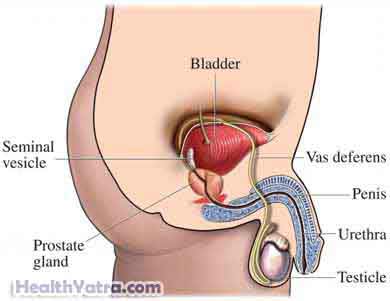परिभाषा
Infertility is not being able to conceive after a year of regular, unprotected sex. About one-third of infertility is caused by male factors and one-third are caused by female factors. In the remaining cases, the cause is unknown or is due to problems with both partners.
Men are considered infertile if they:
- Produce too few sperm cells
- Produce sperm cells of poor quality
- Have chronic problems with ejaculation

Portions of the brain called the pituitary gland and hypothalamus, as well as male reproductive organs such as testes affect fertility in men. Problems in any of these areas may decrease fertility.
In about half of the cases, a cause cannot be found. Some factors that can contribute to infertility include:
- Genetics diseases (such as, Klinefelter syndrome, Sertoli-Leydig cell syndrome)
- Exposure to some workplace chemicals or heavy metals (primarily lead and cadmium)
- Tobacco use, marijuana use
- Varicose veins of the testes (varicocele)
- Abnormal hormone levels
- संक्रमणों
- Physical abnormalities
- कैंसर
- दवाएं
- मोटापा
- Chronic diseases (such as, sickle cell anemia)
- Excessive physical activity
- Anti-sperm antibodies
जोखिम कारक
These factors increase your chance of developing infertility:
- Exposure to toxic chemicals or heavy metals, such as lead
- यकृत रोग
- Nicotine use, long-term marijuana or cocaine use, steroid use, opiate use, and certain prescription drug use
- Exposure to diethylstilbestrol (DES) in the womb
- कीमोथेरपी
- कुपोषण
- Overheating of the testicles
- पुटीय तंतुशोथ
- Klinefelter syndrome
- Kartagener syndrome
- मधुमेह
- रीड़ की हड्डी में चोटें
- मल्टीपल स्क्लेरोसिस
- Brain tumors, pituitary tumors
- Radiation treatment
- Past infections, including sexually transmitted diseases (STDs), mumps, prostatitis
- Birth defects of the male reproductive system, including history of undescended testicles
- Obesity, high body mass index
Tell your doctor if you have any of the above risk factors.
लक्षण
Inability to have a child after one year of trying to conceive.
निदान
During the first visit, you and your partner will both be evaluated. The doctor will ask about symptoms, medical history, and work history. Your doctor will look for potential exposure to certain chemicals. Your doctor will also look for physical problems that might cause infertility.
The following tests will be done:
- Blood tests—to find out the levels of different hormones that play a role in sperm development, including:
- टेस्टोस्टेरोन
- Luteinizing hormone
- Follicle stimulating hormone
- प्रोलैक्टिन का स्तर
- Semen analysis—examined for:
- Amount of semen
- Consistency of semen
- Number of sperm
- Movement of sperm
- Shape of sperm
- “Clumping” of sperm
- Presence of substances other than sperm in the semen
- Other tests:
- Ultrasound—a test that uses sound waves to examine structures inside the body; transrectal ultrasound may be done to look for any enlarged vein around the testicles
- X-rays—a test that uses radiation to take a picture of structures inside the body
- Fertilization tests—to determine how well the sperm can penetrate an egg
- Biopsy—removal of a sample of testicular tissue for testing
- Post-coital test—to check if your sperm is compatible with the mucus in your partner’s cervix
उपचार
Treatment depends on what is causing the condition. Treatments can be costly and lengthy. They often are not covered by insurance.
जीवन शैली में परिवर्तन
Lifestyle changes may include:
- Changing the timing of sexual activity
- Avoiding excessive heat (steam rooms, saunas)
- Avoiding tobacco, marijuana, and excessive alcohol use
- Wearing looser fitting shorts and pants
- Maintaining a healthy weight
- Decreasing stress
Ask you doctor if a daily antioxidant supplement may help.
दवा
If you have a hormonal imbalance, your doctor may prescribe medication. Clomiphene citrate (Clomid, Serophene), for example, is an anti-estrogen drug. In combination with vitamin E, it may help increase sperm count and improve sperm movement.
सर्जरी
Surgery is done for conditions like varicocele that can affect fertility. Treatment of a varicocele does not always restore fertility.
Surgery may also be done to reverse a vasectomy. This reversal is not always successful.
Assisted Reproductive Technologies (ART)
ART involves using human sperm and eggs or embryos in a lab to help with conception. The eggs and sperm can be from you and your partner or donated. ART methods include:
- Artificial insemination—semen is collected and processed in a lab. It is then inserted directly into the woman’s cervix or uterus.
- In vitro fertilization (IVF)—an egg is removed from the woman’s body and mixed with sperm in a lab. The egg and sperm mixture or a 2-3 day old embryo is then placed in the uterus.
- Gamete or zygote intrafallopian transfer (GIFT or ZIFT)—an egg is removed from the woman’s body and mixed with sperm in a lab. The egg and sperm mixture or a 2-3 day old embryo is then placed in the fallopian tube.
- Blastocyst intrafallopian transfer—an egg is removed from the woman’s body. Egg is injected with sperm and allowed to develop. It is later implanted into the uterus.
- Intracytoplasmic sperm injection—a single sperm is injected into the egg. The resulting embryo can be implanted into the uterus or frozen for later use.
रोकथाम
Infertility cannot always be prevented; however, the following steps may help:
- Avoid:
- Use of tobacco, marijuana, opiates, and anabolic steroids
- Exposure to harmful chemicals and heavy metals
- Excessive use of alcohol
- Protect yourself from STDs by using condoms. Minimize the number of sexual partners you have.
